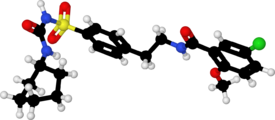Chemistry:Glibenclamide
 | |
 | |
| Clinical data | |
|---|---|
| Trade names | Diabeta, Glynase, Micronase, others[1] |
| Other names | Glyburide (USAN US) |
| AHFS/Drugs.com | Monograph |
| MedlinePlus | a684058 |
| License data | |
| Pregnancy category |
|
| Routes of administration | By mouth |
| ATC code | |
| Legal status | |
| Legal status | |
| Pharmacokinetic data | |
| Protein binding | Extensive |
| Metabolism | Liver hydroxylation (CYP2C9-mediated) |
| Elimination half-life | 10 hours |
| Excretion | Kidney and bile duct |
| Identifiers | |
| |
| CAS Number | |
| PubChem CID | |
| IUPHAR/BPS | |
| DrugBank | |
| ChemSpider | |
| UNII | |
| KEGG | |
| ChEBI | |
| ChEMBL | |
| Chemical and physical data | |
| Formula | C23H28ClN3O5S |
| Molar mass | 494.00 g·mol−1 |
| 3D model (JSmol) | |
| Melting point | 169 to 170 °C (336 to 338 °F) |
| |
| |
| (verify) | |
Glibenclamide, also known as glyburide, is an antidiabetic medication used to treat type 2 diabetes.[1] It is recommended that it be taken together with diet and exercise.[1] It may be used with other antidiabetic medication.[1] It is not recommended for use by itself in type 1 diabetes.[1] It is taken by mouth.[1]
Common side effects include nausea and heartburn.[1] Serious side effects may include angioedema and low blood sugar.[1] It is generally not recommended during pregnancy but can be used during breastfeeding.[3] It is in the sulfonylureas class of medications and works by increasing the release of insulin from the pancreas.[1]
Glibenclamide was discovered in 1969 and approved for medical use in the United States in 1984.[4][1] It is available as a generic medication.[3] In 2022, it was the 200th most commonly prescribed medication in the United States, with more than 2 million prescriptions.[5][6]
Medical uses
Glibenclamide is indicated as an adjunct to diet and exercise to improve glycemic control in adults with type 2 diabetes.[2]
It is not as good as either metformin or insulin in those who have gestational diabetes.[7]
Side effects
Frequently reported side effects include: nausea, heartburn, weight gain, and bloating.[8] The medication is also a major cause of medication-induced hypoglycemia. The risk is greater than with other sulfonylureas.[9]
Contraindications
Glibenclamide may be not recommended in those with G6PD deficiency, as it may cause acute hemolysis.[10]
Pregnancy and breastfeeding
It is generally not recommended during pregnancy but can be used during breastfeeding.[3]
Mechanism of action
The medication, a sulfonylurea, works by binding to and inhibiting the ATP-sensitive potassium channels (KATP) inhibitory regulatory subunit sulfonylurea receptor 1 (SUR1)[11] in pancreatic beta cells. This inhibition causes cell membrane depolarization, opening voltage-dependent calcium Channels.[12]
This results in an increase in intracellular calcium in the pancreatic beta cell and subsequent stimulation of insulin release.[13]
After a cerebral ischemic insult, the blood–brain barrier is broken and glibenclamide can reach the central nervous system. Glibenclamide has been shown to bind more efficiently to the ischemic hemisphere.[14] Moreover, under ischemic conditions SUR1, the regulatory subunit of the KATP- and the NCCa-ATP-channels, is expressed in neurons, astrocytes, oligodendrocytes, endothelial cells[15] and by reactive microglia.[14]
As per the research papers, this sulphonylurea drugs also has extra hepatic effects. It works by inhibiting the enzyme Carnityl Acyl Transferase I (CAT-I) indirectly which is present in the mitochondria. This prevents the transport of long chain fatty acids into the mitochondria for beta-oxidation. This prevents hyperglycemia for which it is prescribed.[16][17]
History
It was developed in 1966 in a cooperative study between Boehringer Mannheim (now part of Roche) and Hoechst (now part of Sanofi-Aventis).[18]
Society and culture
Brand names
Glibenclamide is available as a generic medication, is manufactured by many pharmaceutical companies and is sold under many brand names including Gliben-J, Daonil,[19] Diabeta,[20] Euglucon, Gilemal, Glidanil, Glybovin, Glynase, Maninil, Micronase and Semi-Daonil. It is also available in a fixed-dose combination drug with metformin that is sold under various trade names, e.g. Bagomet Plus, Benimet, Glibomet, Gluconorm, Glucored, Glucovance, Metglib and many others.[21]
References
- ↑ 1.0 1.1 1.2 1.3 1.4 1.5 1.6 1.7 1.8 1.9 "Glyburide Monograph for Professionals". American Society of Health-System Pharmacists. https://www.drugs.com/monograph/glyburide.html.
- ↑ 2.0 2.1 "Glynase- glyburide tablet". 7 October 2017. https://dailymed.nlm.nih.gov/dailymed/drugInfo.cfm?setid=a7fce80a-2f13-43cc-8e1c-561f7d3ec3d5.
- ↑ 3.0 3.1 3.2 British national formulary : BNF 76 (76 ed.). Pharmaceutical Press. 2018. pp. 692. ISBN 9780857113382.
- ↑ Diabetes in Clinical Practice: Questions and Answers from Case Studies. John Wiley & Sons. 2007. p. 342. ISBN 9780470059135. https://books.google.com/books?id=fs0M4dPuNtUC&pg=PA342.
- ↑ "The Top 300 of 2020". https://clincalc.com/DrugStats/Top300Drugs.aspx.
- ↑ "Glyburide - Drug Usage Statistics". https://clincalc.com/DrugStats/Drugs/Glyburide.
- ↑ "Glibenclamide, metformin, and insulin for the treatment of gestational diabetes: a systematic review and meta-analysis". BMJ 350: h102. January 2015. doi:10.1136/bmj.h102. PMID 25609400.
- ↑ "Glyburide: MedlinePlus Drug Information". https://medlineplus.gov/druginfo/meds/a684058.html.
- ↑ "A systematic review and meta-analysis of hypoglycemia and cardiovascular events: a comparison of glyburide with other secretagogues and with insulin". Diabetes Care 30 (2): 389–394. February 2007. doi:10.2337/dc06-1789. PMID 17259518.
- ↑ "Glyburide-induced acute haemolysis in a G6PD-deficient patient with NIDDM". British Journal of Haematology 92 (1): 159–160. January 1996. doi:10.1046/j.1365-2141.1996.275810.x. PMID 8562390.
- ↑ "Glibenclamide, a blocker of K+(ATP) channels, shows antileishmanial activity in experimental murine cutaneous leishmaniasis". Antimicrobial Agents and Chemotherapy 50 (12): 4214–4216. December 2006. doi:10.1128/AAC.00617-06. PMID 17015627.
- ↑ "Glibenclamide Directly Prevents Neuroinflammation by Targeting SUR1-TRPM4-Mediated NLRP3 Inflammasome Activation In Microglia". Molecular Neurobiology 59 (10): 6590–6607. October 2022. doi:10.1007/s12035-022-02998-x. PMID 35972671.
- ↑ "Glyburide". Wolters Kluwer N.V.. https://www.wolterskluwer.com/en/solutions/lexicomp.
- ↑ 14.0 14.1 "ATP-dependent potassium channel blockade strengthens microglial neuroprotection after hypoxia-ischemia in rats". Experimental Neurology 235 (1): 282–296. May 2012. doi:10.1016/j.expneurol.2012.02.010. PMID 22387180.
- ↑ "Sulfonylurea receptor 1 in central nervous system injury: a focused review". Journal of Cerebral Blood Flow and Metabolism 32 (9): 1699–1717. September 2012. doi:10.1038/jcbfm.2012.91. PMID 22714048.
- ↑ "More direct evidence for a malonyl-CoA-carnitine palmitoyltransferase I interaction as a key event in pancreatic beta-cell signaling". Diabetes 43 (7): 878–883. July 1994. doi:10.2337/diab.43.7.878. PMID 8013751.
- ↑ "Glibenclamide inhibits islet carnitine palmitoyltransferase 1 activity, leading to PKC-dependent insulin exocytosis". American Journal of Physiology. Endocrinology and Metabolism 285 (2): E438–E446. August 2003. doi:10.1152/ajpendo.00057.2003. PMID 12684219.
- ↑ "Glibenclamide, a new sulphonylurea: whither oral hypoglycaemic agents?". Drugs 1 (2): 109–115. 1971. doi:10.2165/00003495-197101020-00001. PMID 4999930.
- ↑ "Daonil" (in en). https://www.news-medical.net/drugs/Daonil.aspx.
- ↑ "DiaBeta (Glyburide Tablets): Uses, Dosage, Side Effects, Interactions, Warning" (in en). https://www.rxlist.com/diabeta-drug.htm.
- ↑ "Glyburide and metformin". Wolters Kluwer N.V.. https://www.wolterskluwer.com/en/solutions/lexicomp.
External links
- "Glyburide". Drug Information Portal. U.S. National Library of Medicine. https://druginfo.nlm.nih.gov/drugportal/name/glyburide.
 |

